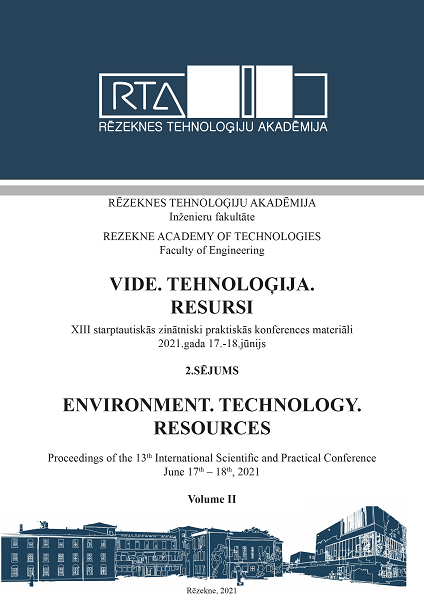RESEARCH OF APPROACHES TO THE RECOGNITION OF SEMANTIC IMAGES OF SCIENTIFIC PUBLICATIONS BASED ON NEURAL NETWORKS
DOI:
https://doi.org/10.17770/etr2021vol2.6628Keywords:
semantic image, pattern recognition, semantic search, classification of scientific publications, neural network.Abstract
The paper is devoted to the problems of orientation and navigation in the world of verbal presentation of scientific knowledge. The solution of these problems is currently hampered by the lack of intelligent information retrieval systems that allow comparing descriptions of various scientific works at the level of coincidence of semantic situations, rather than keywords. The article discusses methods for the formation and recognition of semantic images of scientific publications belonging to specific subject areas. The method for constructing a semantic image of a scientific text developed by Iuliia Bruttan allows to form an image of the text of a scientific publication, which can be used as input data for a neural network. Training of this neural network will automate the processes of pattern recognition and classification of scientific publications according to specified criteria. The approaches to the recognition of semantic images of scientific publications based on neural networks considered in the paper can be used to organize the semantic search for scientific publications, as well as in the design of intelligent information retrieval systems.
Downloads
References
X. Zhang, J. Zhao, Ya. LeCun, “Character-level convolutional networks for text classification,” Proc. Neural Inform. Processing Systems Conf. (NIPS 2015), Montreal, Canada, 2015. [Online]. Available: https://arxiv.org/abs/1509.01626 [Accessed: May 20, 2020].
R. Ju, “An Efficient Method for Document Categorization Based on Word2vec and Latent Semantic Analysis,” 2015 IEEE Int. Conf. on Computer and Information Technology; Ubiquitous Computing and Communications; Dependable, Auto-nomic and Secure Computing; Pervasive Intelligence and Computing, Liverpool, UK, 2015, pp. 2276-2283.
M. Pontiki, D. Galanis, J. Pavlopoulos, H. Papageorgiou, I. Androutsopoulos, and S. Manandhar, “SemEval-2014 Task 4: Aspect based sentiment analysis,” Proc. 8th Int. Workshop on Semantic Evaluation (SemEval 2014), Dublin, Ireland, 2014, pp. 27–35.
J. Pennington, R. Socher, and C. Manning, “Glove: Global vectors for word representation,” Proceedings of the 2014 Conference on Empirical Methods in Natural Language Processing (EMNLP), Doha, Qatar, 2014, pp. 1532-1543.
D. A. Pospelov, Logical-linguistic models in management. Moscow: Energoizdat, 1981. (in Russian)
V. Sh. Rubashkin, Representation and analysis of meaning in intelligent information systems. Moscow: Nauka, 1989. (in Russian)
V. K. Finn, “Information systems and problems of their intellectualization,” NTI, Ser. 1, No. 1, pp. 1-14, 1981. (in Russian)
I. A. Mel'chuk, Experience in the theory of linguistic models "meaning-text". Moscow: Nauka, 1982. (in Russian)
M. Minsky, Frames for knowledge representation. Moscow: Energiya, 1979. (in Russian)
Iu. V. Bruttan, “Intellectualization of the behavior of computers based on the use of a cellular automaton of a new type,” Nauchno-tekhnicheskie vedomosti SPbSPU, No. 2, pp. 225-229, 2007. (in Russian)
Iu. V. Bruttan, “Linguistic processor for processing scientific knowledge,” Energy - XXI century, No. 4 (104), pp. 82-85, 2018. (in Russian)
Iu. V. Bruttan, Methods for spatial representation and analysis of text descriptions for information retrieval systems. Monograph. Pskov: Pskov State University, 2016. (in Russian)
R. Gonzalez, Digital image processing. Moscow: Technosphere, 2005. (in Russian)
Ya. A. Fomin, Pattern Recognition: Theory and Applications. 2nd ed. Moscow: FAZIS, 2012. (in Russian)
V. V. Alexandrov, Automated information processing in the predicate language. Moscow: Nauka, 1982. (in Russian)
I. Antonov, Iu. Bruttan, L. Motaylenko, and D. Andreev, “The Method of Automated Building of Domain Ontology,” in proceedings of the 12th International Scientific and Practical Conference on Environment. Technology. Resources, Rezekne, 2019, vol. II, pp. 34-37.
D. A. Andreev and M. V. Voronov, “Method for constructing an ontology of technological actions,” Bulletin of Saratov State Technical University, No. 3 (67), pp. 160–168, 2012. (in Russian)
B. Benjamin, B. Rebecca, and O. Tony, Applied analysis of text data in Python. Machine Learning and Building Natural Language Processing Applications. Saint-Petersburg: Peter, 2019. (in Russian)
Y. Goldberg, “A primer on neural network models for natural language processing,” Journal of Artificial Intelligence Research, vol. 57, pp. 345–420, 2016.
A. Tor, R. A. Shirvani, Y. Keneshloo, N. Tavvaf, and E. A. Fox, “Natural language processing advancements by deep learning: A survey,” 2020, arXiv:2003.01200. [Online]. Available: http://arxiv.org/abs/2003.01200 [Accessed: May 24, 2020].
M. Ghiassi, M. Olschimke, B. Moon, and P. Arnaudo, “Automated text classification using a dynamic artificial neural network model,” Expert Systems with Applications, No. 39, pp. 10967– 10976, 2012.


